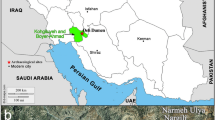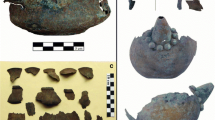Abstract
A large number of Cu-based archaeological artefacts from the Mediterranean basin have been selected for investigation of their chemical composition, metallurgical features and corrosion products (i.e. the patina).
The guidelines for the selection of the Cu-based artefacts have taken into account the representativeness of the Mediterranean archaeological context, the manufacturing technique, the degradation state and the expected chemical composition and structure of the objects.
The results show wide variation of the chemical composition of the alloys that include all kinds of ancient Cu-based alloys such as low and high tin, and also leaded bronzes, copper and copper-iron alloys.
The examination of the alloy matrix shows largely different metallurgical features thus indicating the use of different manufacturing techniques for producing the artefacts. The results of the micro-chemical investigation of the patina show the structures and the chemical composition of the stratified corrosion layers where copper or tin depletion phenomenon are commonly observed with a remarkably surface enrichment of some soil elements such as P, S, Ca, Si, Fe, Al and Cl. This information indicates the strict interaction between soil components and corrosion reactions and products. In particular, the ubiquitous and near constant presence of chlorine in the corrosion layers is observed in the patina of the archaeological Cu-based artefacts found in different contexts in Italy, Turkey, Jordan, Egypt, Spain and Tunisia. This latter occurrence is considered dangerous because it could induce a cyclic corrosion reaction of copper that could disfigure the artefact.
The micro-chemical and micro-structural results also show that another source of degradation of the bronze archaeological artefacts, are their intrinsic metallurgical features whose formation is induced during the manufacturing of the objects, carried out in ancient times by repeated cycles of cold or hot mechanical work and thermal treatments. These combined treatments induce crystallisation and segregation phenomena of the impurities along the grain boundaries and could cause mechanical weakness and increase the extent of the inter-granular corrosion phenomena.
Similar content being viewed by others
References
D.A. Scott, J. Am. Inst. Conserv. 29, 193 (1990)
D.A. Scott, Copper and Bronze in Art, Corrosion, Colorants, Conservation (Ed. Paul Getty Conservation Inst., Malibou CA, USA, 2002) p. 224
C.G. Fink, The Corrosion Handbook, ed. by H.H. Uhlig (Wiley, New York, 1948) p. 103
D.A. Scott, Stud. Conserv. 30, 49 (1985)
L. Robbiola, J.-M. Blengino, C. Fiaud, Corros. Sci. 40, 2083 (1998)
EFESTUS project Reports and Deliverables (6, 12, 18, 24 and 30 Months Reports, D2.1, D3.1, D3.2, D4.1, D4.2, D5.1, D6.1, D6.2, D6.3, D6.4 Deliverables, INCOMED contract n ICA3-CT-2002-10030, acronym EFESTUS)
G.M. Ingo, L.I. Manfredi, G. Bultrini, S. Caroli, G. Chiozzini, P. delle Femmine, Materials Issues in Art and Archaeology V, Vol. 462, Mater. Res. Soc. (1998) p. 417
G.M. Ingo, L.-I. Manfredi, S. Caroli, G. Bultrini, G. Chiozzini, Proc. XII Int. Numismatischer Kongress, ed. by B. Kluge, B. Weisser (Berlin 2000) pp. 306–316
D. Attanasio, G. Bultrini, G.M. Ingo, Archaeometry 43, 529 (2001)
P.T. Craddock, J. Archaeol. Sci. 3, 93 (1976)
P.T. Craddock, J. Archaeol. Sci. 4, 103 (1977)
A.R. Giumlia-Mair, Archaeometry 34, 107 (1992)
P. Lucey, Brit. Corros. J. 7, 36 (1972)
Author information
Authors and Affiliations
Corresponding author
Additional information
PACS
68.55.Jk; 68.35.Dv; 68.37.Hk; 68.55.Nq; 81.05.Bx
Rights and permissions
About this article
Cite this article
Ingo, G., de Caro, T., Riccucci, C. et al. Large scale investigation of chemical composition, structure and corrosion mechanism of bronze archeological artefacts from Mediterranean basin. Appl. Phys. A 83, 513–520 (2006). https://doi.org/10.1007/s00339-006-3550-z
Received:
Accepted:
Published:
Issue Date:
DOI: https://doi.org/10.1007/s00339-006-3550-z




